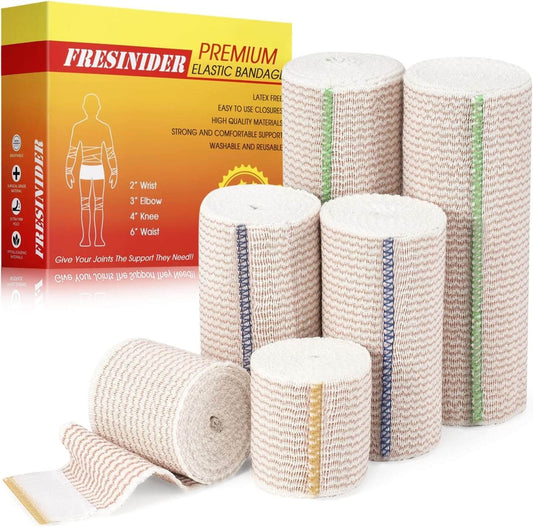Varicose veins are common and can cause heaviness, swelling, and discomfort in the legs. While procedures can address the root cause, compression therapy is one of the most effective non-invasive ways to relieve symptoms. Besides compression stockings, elastic bandages (compression wraps) offer flexible, adjustable support—especially helpful for swelling episodes, post-procedure care, or leg shapes that make stockings hard to wear.
1. What Are Elastic Bandages and How Do They Help with Varicose Veins?
Elastic bandages are stretchable medical wraps that apply gentle but firm pressure to the leg. This external compression supports vein walls and encourages upward blood flow, helping reduce pooling—the main driver of varicose vein symptoms.
If you’d like to learn more about how elastic bandages work, click here to read our detailed guide.
Elastic Bandages vs. Compression Stockings
| Feature | Elastic Bandage | Compression Stockings |
|---|---|---|
| Fit | Custom wrap for any leg shape; fully adjustable | Fixed size/pressure; can be tight or hard to don |
| Flexibility | Easy to apply, remove, and re-adjust during the day | Best for stable daily wear; less adjustable |
| Use Case | Swelling episodes, post-procedure, sensitive skin | Long-term symptom control when fit is good |
| Cost | Affordable and reusable | Typically higher cost |
2. Key Benefits of Elastic Bandages for Varicose Veins
- Improve circulation and venous return: gentle, even pressure encourages upward blood flow.
- Reduce swelling and leg fatigue: limits fluid buildup (edema) to ease heaviness and throbbing.
- Support vein walls and slow progression: consistent compression supports weakened veins.
- Aid recovery after procedures: helps control swelling and speed comfort after sclerotherapy or ablation (follow clinician guidance).
- Support healing of venous ulcers: in severe disease, multi-layer wraps can assist wound care (under medical supervision).
3. How to Use an Elastic Bandage for Varicose Veins
Step-by-Step Application
- Start in the morning when swelling is lowest.
- Sit or lie down and elevate the leg.
- Begin wrapping just above the ankle, moving upward toward the knee or thigh.
- Overlap each turn by about half the bandage’s width; keep the roll close to the skin for even tension.
- Maintain a wrap that’s snug but not tight—toes should remain warm and pink; you should be able to slip two fingers under the wrap.
- Secure the end with Velcro or clips and check circulation after a few minutes.
4. When and How Long to Wear
- Daytime use: wear while walking, standing, or during long periods of sitting.
- Night: remove before sleeping unless your clinician advises otherwise.
- Post-procedure: follow your provider’s instructions (often continuous for 24–48h, then daytime only).
5. Choosing the Right Elastic Bandage
- Stretch type: short-stretch (low resting/high working pressure) for more advanced disease or ulcers; medium-stretch for mild-to-moderate symptoms.
- Material: breathable, latex-free fabric for comfort and skin friendliness; washable and durable.
- Compression level: stockings specify mmHg; bandage pressure depends on technique—aim for a moderate equivalent (often ~20–30 mmHg for mild–moderate cases).
- Width & length: choose 2”, 3”, 4”, or 6” depending on area (ankle/calf vs. thigh) with enough length for overlap.
- Closure: Velcro is fast and secure; clips are classic and budget-friendly.
6. Tips to Maximize Results
- Apply the wrap before getting out of bed to capture the lowest-swelling fit.
- Combine with regular walking and calf-pump exercises.
- Elevate legs for 15–20 minutes during the day.
- Maintain a healthy weight; avoid prolonged static standing or sitting.
- Rewrap as needed during the day to keep pressure even; hand-wash and air-dry to preserve elasticity.
7. When to Consult a Doctor
Elastic bandages help manage symptoms but do not cure varicose veins. Seek medical advice if you notice:
- Persistent or worsening pain, redness, warmth, or swelling
- Numbness, tingling, or color changes under the wrap
- Non-healing wounds/ulcers, or sudden one-leg swelling (possible DVT)
Use compression with caution and professional guidance if you have diabetes, arterial disease, or heart failure.
8. Why Consider FRESINIDER Elastic Bandage for Varicose Vein Support
- Adjustable, consistent compression to reduce swelling and support veins
- Soft cotton, breathable, latex-free—comfortable for daily wear
- Washable & reusable for long-term value
- Secure closures (Velcro or clips) and multiple widths (2”, 3”, 4”, 6”)
Explore our options: Elastic Bandage with Velcro | Elastic Bandage with Clips
Compliance note: This article shares supportive care information for varicose veins. It does not diagnose, treat, or cure disease. Always follow advice from your healthcare professional.





